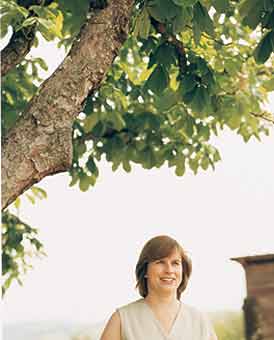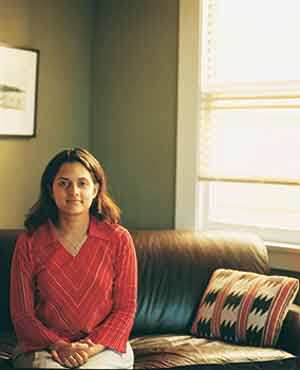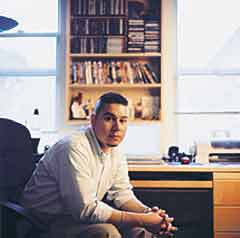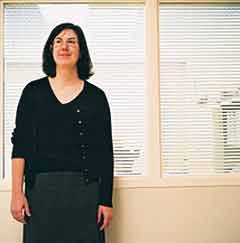 |
|
Kristine McCoy, medical student. |
|
Medical students bring skills to the community
By Christopher Vaughan
Photographs by Leslie Williamson and Meredith Heuer
Stanford five years ago she noticed something odd. Many of her classmates were not only bright and ambitious but had a great deal of interest and experience in public service or community medicine. Yet here they all were at Stanford, a school that offered great opportunity for students with a bent for laboratory research but relatively little at the time for those desiring training in community medicine.
McCoy is among those who came to Stanford with community medicine experience. She earned a master’s of public health from UCLA, did some research and then spent five years working for the U.S. Public Health Service. At Stanford, she could have gotten involved with the student-run free clinic, but she was interested in a more academically oriented program. She learned that students Steven Chen and Naomi Steiner had made an effort to create a community medicine course the year before, and she pitched in to help build on those efforts.
The result was the Public Service Medical Scholars program, known as PriSMS. Though her experience working for the federal government helped her advocate successfully, McCoy credits faculty members Phyllis Gardner, MD, and William Mobley, MD, PhD, with shepherding the program into being. “There was generally a good response on the part of the administration, but Dr. Gardner was a huge help and Dr. Mobley had to talk a few very skeptical people into this and helped to raise money.”
Under the leadership of director Tim Stanton and associate director Ann Banchoff, the program aims to give students community-based research opportunities while providing local groups the help they want.
“One of our main principles is that the need for service or research must be identified at the community level. This way student work creates more sustainable change,” Banchoff says.
The PriSMS program has two components. One is Medicine 270, a course to build knowledge and skills for work with underserved communities. The course requires students to take on a project that allows them to apply what they’ve learned. The other part is the Community Partnership Medical Scholars program, through which students apply for grants to do scholarly community-partnership studies that are more research-oriented than Med 270 projects might be.
In January 2000, the medical school launched the coursework component, selecting 14 medical students for the inaugural class. Then in fall 2001, the school opened the grants program. To date, 14 students have received community partnership research grants and 50 have passed through the Med 270 curriculum.
Many medical students have found that the program offers exactly what they wanted but never expected at Stanford. “I came to medical school intending to help African immigrant communities,” says Khaliah Johnson. “So it was perfect when I found Ethiopian Community Services in San Jose and the PriSMS program.” Through Med 270, Johnson began working with Ethiopian women to promote health within the community. She and the community ser adequate diet.
As Trivedi applied for a Community Partnership Medical Scholars grant she had ambitious plans for her project. But as part of the planning process she managed to find Usha Chitkara, MD, a Stanford professor of obstetrics and gynecology who had trained in India and knew what was practicable in the field.
“I had all these great ideas, but she told me that I wouldn’t be able to do all these tests,” Trivedi says. “With the heat and humidity and without electricity I wouldn’t be able to preserve samples until I could take them to a lab.”
Trivedi was able to administer a survey about eating habits, determine the women’s body-mass index and, with a portable spectrophotometer, get blood hemoglobin levels.
She did have problems that no amount of planning could anticipate, however. Her first visit to the community fell immediately after the 9/11 attacks, and she wondered how she would be received in a Muslim community. But she found that people didn’t care about that. With barely any shelter or food, they were much more concerned with getting by every day.
Trivedi expected the pregnant women to be in the worst shape nutritionally, but to her surprise the study revealed that the non-pregnant, non-breastfeeding women were actually the worst off. As a result, she designed interventions to promote the consumption of leafy green vegetables and to encourage women to wait for marriage until at least four years after they begin menstruating. For pregnant women she gave advice on how to eat foods that would supply sufficient iron, and on the weight they should be gaining. “There’s a common feeling that the baby should be kept small to make birth easier,” says Trivedi. She worked to dispel this myth.
Before she could test the interventional strategies, however, another traumatic event occurred. Anti-Muslim riots swept the community. People attacked and killed their neighbors and destroyed their property. “The boundaries were very distinct — if your neighbor was Muslim you hated them, and even people who were well-educated succumbed to these feelings.” Trivedi says. “I felt very alone in my view of what was actually going on.”
The rioting has now subsided, and Trivedi is back in India to see how the community is doing.
 |
|
Kavita Trivedi |
|
Balm for a Troubled Land
Improving women’s nutrition in Ahmebabad , India
Kavita Trivedi’s parents, who came to the United States from India 35 years ago, made volunteer work to benefit their homeland a family habit. So when Trivedi decided to launch a community-based research project, she had a natural interest in returning to south Asia .
Her specific interest was the nutrition of women in disadvantaged communities. Her goal was to compare nutritional status in women who were pregnant, women who were breastfeeding and women who were not pregnant or breastfeeding.
The community that Trivedi chose was particularly troubled. The city of Ahmebabad lies in the state of Gujarat , which was hit in 2001 by a large and destructive earthquake. The group of women within Ahmebabad on which Trivedi focused was part of a Muslim minority community with few material possessions and an inadequate diet.
As Trivedi applied for a Community Partnership Medical Scholars grant she had ambitious plans for her project. But as part of the planning process she managed to find Usha Chitkara, MD, a Stanford professor of obstetrics and gynecology who had trained in India and knew what was practicable in the field.
“I had all these great ideas, but she told me that I wouldn’t be able to do all these tests,” Trivedi says. “With the heat and humidity and without electricity I wouldn’t be able to preserve samples until I could take them to a lab.”
Trivedi was able to administer a survey about eating habits, determine the women’s body-mass index and, with a portable spectrophotometer, get blood hemoglobin levels.
She did have problems that no amount of planning could anticipate, however. Her first visit to the community fell immediately after the 9/11 attacks, and she wondered how she would be received in a Muslim community. But she found that people didn’t care about that. With barely any shelter or food, they were much more concerned with getting by every day.
Trivedi expected the pregnant women to be in the worst shape nutritionally, but to her surprise the study revealed that the non-pregnant, non-breastfeeding women were actually the worst off. As a result, she designed interventions to promote the consumption of leafy green vegetables and to encourage women to wait for marriage until at least four years after they begin menstruating. For pregnant women she gave advice on how to eat foods that would supply sufficient iron, and on the weight they should be gaining. “There’s a common feeling that the baby should be kept small to make birth easier,” says Trivedi. She worked to dispel this myth.
Before she could test the interventional strategies, however, another traumatic event occurred. Anti-Muslim riots swept the community. People attacked and killed their neighbors and destroyed their property. “The boundaries were very distinct — if your neighbor was Muslim you hated them, and even people who were well-educated succumbed to these feelings.” Trivedi says. “I felt very alone in my view of what was actually going on.”
The rioting has now subsided, and Trivedi is back in India to see how the community is doing.
 |
|
Daniel Sanchez |
|
Helping Kids Keep Their Health Care
Student project analyzes Santa Clara Family Health Plan’s retention patterns
Daniel Sanchez had always wanted to be a doctor, but before he applied to Stanford he spent two years in Teach for America , giving underprivileged eighth-graders the benefits of his education. “I liked it so much that I almost didn’t come to medical school,” Sanchez says.
“I feel strongly about working with kids in the community, and I feel strongly about the health insurance problem,” Sanchez says — so a Med 270 project working with the Santa Clara Family Health Plan was a natural. The health plan works to provide health-care coverage to families in Santa Clara County , concentrating on those families that tend to slip through the cracks. When he met with the health plan’s representatives, they told Sanchez that they were signing up lots of families for the plan but were worried about families dropping out within a year.
Working with survey results obtained by the health plan, Sanchez is analyzing the factors that contribute to disenrollment. “The hypothesis is that bureaucratic factors lie behind the problem,” Sanchez says. “The hope is that the health plan can use the results to target specific groups so next year the retention rates will be better.”
 |
|
Courtney Griffiths |
|
Keeping Diabetic Patients on Track
With student’s help, Mayview Clinic in Palo Alto gets a computer system
Courtney Griffiths came to Stanford with a master’s of public health and experience as a community care coordinator for prenatal checkups in North Carolina . The PriSMS program gave her a way to continue her community involvement at Stanford.
As part of the Med 270 course, Griffiths asked staff at the Mayview Clinic in Palo Alto what would be useful for them. The clinic, which has a center in Mountain View as well, offers care to low-income and uninsured patients. Griffiths ’ discussions led her to set up a computer system designed to help the clinic track diabetic patients. “The computer system lets them know who is coming in to get their blood tested and so on,” Griffiths says. “The clinic is understaffed and they don’t have any time to have anybody sit down and figure out how to do this, so that’s where I can help.”
Although the project does not offer a chance to practice her clinical skills, there are other personal benefits, she says. “It gives me a clearer idea of what diabetic patients need; it gives me a clearer picture of what’s going on,” she says. “And coming from a background in community health it’s a nice complement to the curriculum. I’ve missed that connection to the community.”
Her experience has been so positive that Griffiths plans to apply for a Community Partnership Medical Scholars grant to study how pregnant women in a Central Valley community view genetic testing and to learn how to present information about such tests in a way that is culturally relevant.
Comments? Contact Stanford Medicine at

